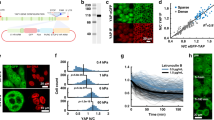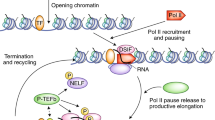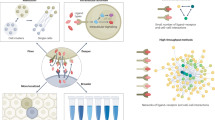Abstract
Recent data support the view that transcription factors — in particular, homeoproteins — can be transferred from cell to cell and have direct non-cell-autonomous (and therefore paracrine) activities. This intercellular transfer, based on atypical internalization and secretion, has important biotechnological consequences. But the real excitement stems from the physiological and developmental implications of this mode of signal transduction.
This is a preview of subscription content, access via your institution
Access options
Subscribe to this journal
Receive 12 print issues and online access
$189.00 per year
only $15.75 per issue
Buy this article
- Purchase on Springer Link
- Instant access to full article PDF
Prices may be subject to local taxes which are calculated during checkout




Similar content being viewed by others
References
Ensoli, B. et al. Release, uptake, and effects of extracellular human immunodeficiency virus type 1 Tat protein on cell growth and viral transactivation. J. Virol. 67, 277–287 (1993).
Prochiantz, A. Messenger proteins: homeoproteins, TAT and others. Curr. Opin. Cell Biol. 12, 400–406 (2000).
Joliot, A. et al. Identification of a signal sequence necessary for the unconventional secretion of Engrailed homeoprotein. Curr. Biol. 8, 856–863 (1998).
Simon, H. H., Saueressig, H., Wurst, W., Goulding, M. D. & O'Leary, D. D. Fate of midbrain dopaminergic neurons controlled by the engrailed genes. J. Neurosci. 21, 3126–3134 (2001).
Lucas, W. J. et al. Selective trafficking of KNOTTED1 homeodomain protein and its mRNA through plasmodesmata. Science 270, 1980–1983 (1995).
Lee, J. Y. et al. Selective trafficking of non-cell-autonomous proteins mediated by NtNCAPP1. Science 299, 392–396 (2003).
Kragler, F., Monzer, J., Xoconostle-Cazares, B. & Lucas, W. J. Peptide antagonists of the plasmodesmal macromolecular trafficking pathway. EMBO J. 19, 2856–2868 (2000).
Joliot, A., Pernelle, C., Deagostini-Bazin, H. & Prochiantz, A. Antennapedia homeobox peptide regulates neural morphogenesis. Proc. Natl Acad. Sci. USA 88, 1864–1868 (1991).
Derossi, D., Joliot, A. H., Chassaing, G. & Prochiantz, A. The third helix of Antennapedia homeodomain translocates through biological membranes. J. Biol. Chem. 269, 10444–10450 (1994).
Lundberg, M. & Johansson, M. Positively charged DNA-binding proteins cause apparent cell membrane translocation. Biochem. Biophys. Res. Commun. 291, 367–371 (2002).
Thoren, P. E., Persson, D., Karlsson, M. & Norden, B. The antennapedia peptide penetratin translocates across lipid bilayers — the first direct observation. FEBS Lett. 482, 265–268 (2000).
Derossi, D. et al. Cell internalization of the third helix of the Antennapedia homeodomain is receptor-independent. J. Biol. Chem. 271, 18188–18193 (1996).
Berlose, J. P., Convert, O., Derossi, D., Brunissen, A. & Chassaing, G. Conformational and associative behaviours of the third helix of Antennapedia homeodomain in membrane-mimetic environments. Eur. J. Biochem. 242, 372–386 (1996).
Chatelin, L., Volovitch, M., Joliot, A. H., Perez, F. & Prochiantz, A. Transcription factor Hoxa-5 is taken up by cells in culture and conveyed to their nuclei. Mech. Dev. 55, 111–117 (1996).
Le Roux, I., Joliot, A. H., Bloch-Gallego, E., Prochiantz, A. & Volovitch, M. Neurotrophic activity of the Antennapedia homeodomain depends on its specific DNA-binding properties. Proc. Natl Acad. Sci. USA 90, 9120–9124 (1993).
Maizel, A., Bensaude, O., Prochiantz, A. & Joliot, A. A short region of its homeodomain is necessary for Engrailed nuclear export and secretion. Development 126, 3183–3190 (1999).
Joliot, A. et al. Association of engrailed homeoproteins with vesicles presenting caveolae-like properties. Development 124, 1865–1875 (1997).
Thery, C. et al. Proteomic analysis of dendritic cell-derived exosomes: a secreted subcellular compartment distinct from apoptotic vesicles. J. Immunol. 166, 7309–7318 (2001).
Hamon, Y. et al. Interleukin-1β secretion is impaired by inhibitors of the Atp binding cassette transporter, ABC1. Blood 90, 2911–2915 (1997).
Gupta, S., Aggarwal, S. & Nakamura, S. A possible role of multidrug resistance-associated protein (MRP) in basic fibroblast growth factor secretion by AIDS-associated Kaposi's sarcoma cells: a survival molecule? J. Clin. Immunol. 18, 256–263 (1998).
Kim, N. et al. Proteins released by Helicobacter pylori in vitro. J. Bacteriol. 184, 6155–6162 (2002).
Ishiwatari, Y. et al. Thioredoxin H is one of the major proteins in rice phloem sap. Planta 195, 456–463 (1995).
Rubartelli, A., Bajetto, A., Allavena, G., Wollman, E. & Sitia, R. Secretion of thioredoxin by normal and neoplastic cells through a leaderless secretory pathway. J. Biol. Chem. 267, 24161–24164 (1992).
Davidson, P. J. et al. Shuttling of galectin-3 between the nucleus and cytoplasm. Glycobiology 12, 329–337 (2002).
Dono, R. & Zeller, R. Cell-type-specific nuclear translocation of fibroblast growth factor-2 isoforms during chicken kidney and limb morphogenesis. Dev. Biol. 163, 316–330 (1994).
Stachowiak, M. K. et al. Regulation of bFGF gene expression and subcellular distribution of bFGF protein in adrenal medullary cells. J. Cell Biol. 127, 203–223 (1994).
Hirota, K. et al. AP-1 transcriptional activity is regulated by a direct association between thioredoxin and Ref-1. Proc. Natl Acad. Sci. USA 94, 3633–3638 (1997).
Cao, Y. & Pettersson, R. Release and subcellular localization of acidic fibroblast growth factor expressed to high levels in HeLa cells. Growth Factors 8, 277–290 (1993).
Gardella, S. et al. The nuclear protein HMGB1 is secreted by monocytes via a non-classical, vesicle-mediated secretory pathway. EMBO Rep. 3, 995–1001 (2002).
Eberhard, D. A., Karns, L. R., VandenBerg, S. R. & Creutz, C. E. Control of the nuclear–cytoplasmic partitioning of annexin II by a nuclear export signal and by p11 binding. J. Cell Sci. 114, 3155–3166 (2001).
Sahaf, B. & Rosen, A. Secretion of 10-kDa and 12-kDa thioredoxin species from blood monocytes and transformed leukocytes. Antioxid. Redox Signal. 2, 717–726 (2000).
Gong, H. C. et al. The NH2 terminus of galectin-3 governs cellular compartmentalization and functions in cancer cells. Cancer Res. 59, 6239–6245 (1999).
Maizel, A. et al. Engrailed homeoprotein secretion is a regulated process. Development 129, 3545–3553 (2002).
Vecchi, M. et al. Nucleocytoplasmic shuttling of endocytic proteins. J. Cell Biol. 153, 1511–1517 (2001).
Mahanty, S. K., Wang, Y., Farley, F. W. & Elion, E. A. Nuclear shuttling of yeast scaffold Ste5 is required for its recruitment to the plasma membrane and activation of the mating MAPK cascade. Cell 98, 501–512 (1999).
Chatterjee, T. K. & Fisher, R. A. Cytoplasmic, nuclear, and Golgi localization of RGS proteins. Evidence for N-terminal and RGS domain sequences as intracellular targeting motifs. J. Biol. Chem. 275, 24013–24021 (2000).
Smart, E. J., Ying, Y. S. & Anderson, R. G. Hormonal regulation of caveolae internalization. J. Cell Biol. 131, 929–938 (1995).
Goutte, C. & Johnson, A. D. Yeast a1 and α2 homeodomain proteins form a DNA-binding activity with properties distinct from those of either protein. J. Mol. Biol. 233, 359–371 (1993).
Gillissen, B. et al. A two-component regulatory system for self/non-self recognition in Ustilago maydis. Cell 68, 647–657 (1992).
Van den Ackerveken, G., Marois, E. & Bonas, U. Recognition of the bacterial avirulence protein AvrBs3 occurs inside the host plant cell. Cell 87, 1307–1316 (1996).
Dumas, F., Duckely, M., Pelczar, P., Van Gelder, P. & Hohn, B. An Agrobacterium VirE2 channel for transferred-DNA transport into plant cells. Proc. Natl Acad. Sci. USA 98, 485–490 (2001).
Desvoyes, B., Faure-Rabasse, S., Chen, M. H., Park, J. W. & Scholthof, H. B. A novel plant homeodomain protein interacts in a functionally relevant manner with a virus movement protein. Plant Physiol. 129, 1521–1532 (2002).
Thomas, C. A., Dobkin, J. & Weinberger, O. K. TAT-mediated transcellular activation of HIV-1 long terminal repeat directed gene expression by HIV-1-infected peripheral blood mononuclear cells. J. Immunol. 153, 3831–3839 (1994).
Bailly, K., Soulet, F., Leroy, D., Amalric, F. & Bouche, G. Uncoupling of cell proliferation and differentiation activities of basic fibroblast growth factor. FASEB J. 14, 333–344 (2000).
Wiedlocha, A., Falnes, P., Madshus, H., Sandvig, K. & Olsnes, S. Dual mode of signal transduction by externally added acidic fibroblast growth factor. Cell 76, 1039–1051 (1994).
Rivera-Pomar, R., Niessing, D., Schmidt, O. U., Gehring, W. J. & Jäckle, H. RNA binding and translational suppression by bicoid. Nature 379, 746–749 (1996).
Dubnau, J. & Struhl, G. RNA recognition and translational regulation by a homeodomain protein Nature 379, 694–699 (1996).
Niessing, D. et al. Homeodomain position 54 specifies transcriptional versus translational control by Bicoid. Mol. Cell 5, 395–401 (2000).
Niessing, D., Blanke, S. & Jäckle, H. Bicoid associates with the 5′-cap-bound complex of caudal mRNA and represses translation. Genes Dev. 16, 2576–2582 (2002).
Topisirovic, I. et al. The proline-rich homeodomain protein, PRH, is a tissue-specific inhibitor of eIF4E-dependent cyclin D1 mRNA transport and growth. EMBO J. 22, 689–703 (2003).
Marie, B., Cruz-Orengo, L. & Blagburn, J. M. Persistent engrailed expression is required to determine sensory axon trajectory, branching, and target choice. J. Neurosci. 22, 832–841 (2002).
Bloch-Gallego, E. et al. Antennapedia homeobox peptide enhances growth and branching of embryonic chicken motoneurons in vitro. J. Cell Biol. 120, 485–492 (1993).
Simeone, A. & Acampora, D. The role of Otx2 in organizing the anterior patterning in mouse. Int. J. Dev. Biol. 45, 337–345 (2001).
Ruiz i Altaba, A. Planar and vertical signals in the induction and patterning of the Xenopus nervous system. Development 116, 67–80 (1992).
Li, J. Y. & Joyner, A. L. Otx2 and Gbx2 are required for refinement and not induction of mid-hindbrain gene expression. Development 128, 4979–4991 (2001).
Bishop, K. M., Rubenstein, J. L. & O'Leary, D. D. Distinct actions of Emx1, Emx2, and Pax6 in regulating the specification of areas in the developing neocortex. J. Neurosci. 22, 7627–7638 (2002).
Toresson, H., Potter, S. S. & Campbell, K. Genetic control of dorsal-ventral identity in the telencephalon: opposing roles for Pax6 and Gsh2. Development 127, 4361–4371 (2000).
Matsunaga, E., Araki, I. & Nakamura, H. Pax6 defines the di-mesencephalic boundary by repressing En1 and Pax2. Development 127, 2357–2365 (2000).
Turing, A. M. The chemical basis of morphogenesis. Bull. Math. Biol. 1990, 153–197 (1953).
Briata, P. et al. EMX1 homeoprotein is expressed in cell nuclei of the developing cerebal cortex and in the axons of the olfactory sensory neurons. Mech. Dev. 57, 169–180 (1996).
Acknowledgements
We would like to thank the members of our groups for many helpful discussions and C. Goridis for his critical reading of the manuscript. Many of the experiments discussed in this article were supported by the Centre National de la Recherche Scientifique and the Ecole Normale Supérieure, and by grants from the Association Française de lutte contre les Myopathies, the Human Frontier Research Program and the European Economic Community.
Author information
Authors and Affiliations
Rights and permissions
About this article
Cite this article
Prochiantz, A., Joliot, A. Can transcription factors function as cell–cell signalling molecules?. Nat Rev Mol Cell Biol 4, 814–819 (2003). https://doi.org/10.1038/nrm1227
Issue Date:
DOI: https://doi.org/10.1038/nrm1227
This article is cited by
-
Non-cell-autonomous OTX2 transcription factor regulates anxiety-related behavior in the mouse
Molecular Psychiatry (2021)
-
Level of hydrogen peroxide affects expression and sub-cellular localization of Pax6
Molecular Biology Reports (2018)
-
Engrailed homeoproteins in visual system development
Cellular and Molecular Life Sciences (2015)
-
Plasmodesmata: intercellular tunnels facilitating transport of macromolecules in plants
Cell and Tissue Research (2013)
-
Engrailed protects mouse midbrain dopaminergic neurons against mitochondrial complex I insults
Nature Neuroscience (2011)



